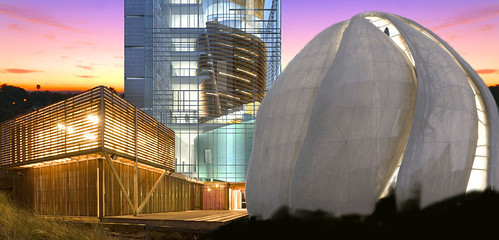On Chile's Temple of Light Is an Award Winner: And construction has begun
Winners of Civic Buildings WAN AWARDS 2010 revealed
The Baha’i Temple for South America, designed by Hariri Pontarini Architects, employs both translucent stone and innovative glass technology as the means of generating and manifesting both the physiological and spiritual delights of natural light embodied in architecture.
Set against the stirring background of the Andeon mountain range, the Temple is designed as a crystallising of light-as-expression, an evanescent structure of white alabaster and glass; a place of pure luminescence. During the day, the soft undulating alabaster and glass skin of the Temple forms its outer expression. At night, the image reverses; the entire volume becomes a warm totalised glow, with the inner form of the building visible through the glass.
The inner form of the Temple, suspended within its radiant exterior envelope, is a volume defined by finely articulated tracery of wood, offering a delicately ornamental inner surface, rich in texture, warm by nature, acoustically practical and responsive to the cultural givens of the area. The Temple’s nine enfolding wings, identical in form, are organically shaped and twisted slightly to produce a nest-like structure, readable as a soft undulating dome positioned around a raised base. The Temple is to be sited amidst a radiating garden comprising of nine reflecting lily pools and nine prayer-gardens. The primary approach to the Temple reveals a sinuous, ethereal, light-washed structure.
The Temple touches lightly on the ground, its base having become virtually transparent, with each of the nine wings practically floating in the horizon. While firmly grounded, in terms of its engineering, the form of the Temple speaks nevertheless of ascendance. It is hoped that the Temple’s design will be seen as a restrained interplay of seeming contradictions; movement against stillness, the building’s profound rootedness made to seem buoyant, the building reading as a symmetrical structure that seems possessed of a performative spirit.


No comments:
Post a Comment